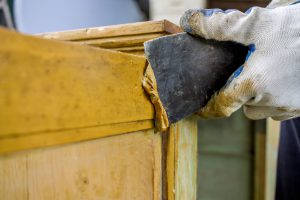
Stripping a coating can be rewarding and it should be environmentally friendly because you are giving an old building, floor or piece of furniture a new lease on life rather than buying new materials. However, this process can compromise your own safety and put dangerous substances into your environment if not done correctly.
old building, floor or piece of furniture a new lease on life rather than buying new materials. However, this process can compromise your own safety and put dangerous substances into your environment if not done correctly.
Personal Safety Gear
It goes without saying that goggles, gloves and respirators are a must when removing paint, stain or varnish. Respiratory disease is a common problem for painters. A 2004 study by the International Archives of Occupational Environmental Health discovered that painters often suffer from chronic bronchitis and were three times more likely to develop asthma when compared to carpenters.
The biggest risk is inhalation of dust that is generated when coatings and paint are removed. That’s why it is important to get the right respirator for the kind of paint you are using.
When removing lead paint, for example, you must wear a N95 respirator which is able to provide sufficient filtration from particles created during the paint-removal process. An R95 respirator is sufficient for latex paints while oil-based paints require a P95 filter.
Paint strippers demand an even more careful approach with continuous-flow supplied-air respirators with a hood or helmet.
Masks alone don’t provide adequate protection from the chemicals and dust associated with the paint removal process, but respirators over masks should do the trick. Respirators should fit tightly and create a seal in order to be effective. Regularly check your workers are wearing their protective gear in the right way.
Lead Paint
We are all aware of the dangers of working with lead paint, but even paints that aren’t lead-based pose health risks as do the chemicals we use to strip them. While lead-based paints have been banned for decades, they can still be found in older homes. Bridges, shops, railways and many other industrial structures are still treated with lead-based paints.
When removing lead paint, you not only have to worry about the safety of your workers, but also of the impact you will have on the environment. Be sure to protect your workers from exposure and contain all the removed lead paint so that it doesn’t end up contaminating the environment.
Solvents
All paints and finishes can pose health threats to users, but the chemicals used to remove them are often more dangerous. The Occupational Safety and Health Administration (OSHA) warns that coatings and solvents can cause damage to the liver and kidneys, reproductive systems, respiratory systems and can result in cancer and dermatitis while proving toxic to the nervous system.
The main threat in solvents comes from methylene chloride which can reduce the blood’s capacity to transport oxygen and can result in cancer, liver damage or kidney ailments.
Reducing Risk
There are some paint-removal techniques which can mitigate risks for example, wet scraping can reduce the amount of dust that is released when removing paint. Using heat to remove paint will also reduce dust levels. Always ensure that work areas are properly ventilated to reduce chemical and dust concentrations and take regular breaks in a well-ventilated area.
